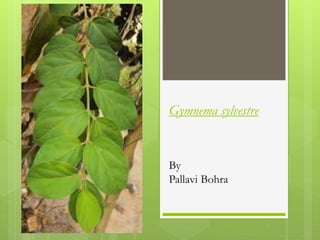
Gymnema sylvestre
- 2. Introduction Ankit Sanejal et.,al Gymnema sylvestre.2010 2 Herb, climber 8 m/600m height Native of southern, central India and Srilanka, africa,Malasiya Also known as Asclepias geminata, Gymnema melicida, and Pinus sylvestris Other names English: Periploca of woods Hindi:Gurmar (Destroyer of sugar) Sanskrit:Madhuashini Marathi:Dhuleti Kannada:Sannageraseha -mbu
- 3. Classification Ankit Sanejal et.,al Gymnema sylvestre.2010 3 Kingdom: Plantae Subkingdom: Tracheobionta Superdivision: Spermatophyta Division: Magnoliophyta Class: Magnoliopsida Subclass: Asteridae Order: Gentianales Family: Asclepiadaceae Genus: Gymnema Species: sylvestre R.Br. (Robert Brown)
- 4. Plant morphology Stem: Arial, hard and branched. Young stem’s branches are smooth and cylindrical. Leaves: Elliptic, base acute to acuminate, glabrous and opposite. Infloroscence: Umbellate cyme with small yellow coloured flowers A.Sabhitha rani et.,al GYMNEMA SYLVESTRE:AN IMPORTANTANTIDIABETICPLANTOF INDIA:.2012 4
- 5. Cultivation Best is sandy loam soil. For preparation : Make soil weed-free 10-12 tonnes/hectare of FYM and 250 kg of NPK added as a basal dose at the time of preparation October-December : Seeds are collected and sown in polybags. Feb-March: Seedling raised are planted in field 1-1.5 m spacing is recommended Green gram can be grown as a intercrop Irrigation require once a week October-Feb. One year leaves are ready to harvest Roots are collected in summers Aphid sp. is observed to attach this plant National medicinal plant board 5
- 6. Harvesting Leaves: 30-40 days leaves can be used One year time is best Post harvesting methods: Dried in shade Packed in polybags Moisture content should only 8% Chemical constitute: 7-9.6% of gymnemic acid Yield and cost of cultivation: 1250 kg of dry leaves from one hectare in every three months Cost of cultivation is 25000 Rs/hectare National medicinal plant board 6
- 7. Phyto Chemistry Ankit Sanejal et.,al Gymnema sylvestre.2010 www.natureherbs.com 7 G.syvestre leaves extract contain oleanane and dammarene classes of triterpene saponins. Major component: Gymnemic acid, gurmarin, gymnemasaponins and gymnemasides Gymenemic acid and gymnemasaponins are group of oleanane type of saponins Dammarene saponins are gymnemasides and gurmarin Other components: Resins, albumin, chlorophyll, carbohydrates, tartaric acid, formic acid, butyric acid, anthraquinone derivatives, inositole Alkaloids, organic acid (5.5%), parabin, calcium oxalate (7.3%), lignin (4.8%), cellulose (22%)
- 8. Nutraceutical values Slow the transport of glucose from the intestine to the bloodstream Lower blood sugar Lower gycosylated heamoglobin HbAC1 Lower glycosylated plasma protein levels Decreasing glycosuria Chewing the leaves destroys the ability to identify the sweet taste Fruits and leaves used for treating blood pressure and heart rhythms http://www.drwhitaker.com/the-benefits-of-gymnema-sylvestre-extract http://www.drugs.com/npc/gymnema.html A.Sabhitha rani et.,al GYMNEMA SYLVESTRE:AN IMPORTANTANTIDIABETICPLANTOF INDIA:.2012 8
- 9. Continue………. Leaves are bitter, astringent and acrid Also, anti-inflammatory, anthelmenthics, cardiotonic, expectorant and antipyretic. Leaves are also used for stomach ailments, water retention, and liver disease, anaemia and eye complaints, jaundice, asthma and leucoderma. Leaves also used to treat snake bite. A.Sabhitha rani et.,al GYMNEMA SYLVESTRE:AN IMPORTANTANTIDIABETICPLANTOF INDIA:.2012 9
- 10. continue….. Lowering serum cholesterol and triglycerides Reduce the complications of retinopathy by 38% Other : Anti-inflammatory, anodyne, digestive, liver tonic, anti-emetic, diuretic, stimulant, laxative, uterine tonic and urinary disorder. Useful in dyspepsia, constipation and jaundice, haemorrhoids, cardiopathy, asthma, bronchitis, amenorrhoea, conjunctivitis and leucoderma Ankit Sanejal et.,al Gymnema sylvestre.2010 10
- 11. Mechanism of G.sylvestre (Gymnemic acid)- hypogycimic effect It promotes regeneration of islet cells It increases secretion of insulin It causes inhibition of glucose absorption from intestine It increases utilization of glucose as it increase the activities of enzymes responsible for utilization of glucose by insulin-dependent pathways, an increase in phosphorylase activity, decrease in gluconeogenic enzymes and sorbitol dehydrogenase Decrease glucose absorption in the intestine Ankit Sanejal et.,al Gymnema sylvestre.2010 11
- 12. Ethnobotanical Uses (Tribal people) Jungle Irulas , Bourgeois classes inhabitants of Nagari Hills (North Arcot District, Bombay and Gujarat): Habit of chewing a few green leaves in the morning in order to keep their urine clear and to reduce glycosuria Vaids (Bombay and Madras): Used leaves in the treatment of furunculosis and madhumeha (Honey urine) Juice obtained from root is used to treat vomiting and in dysentery Plant paste is applied with mother’s milk to treat mouth ulcer Ankit Sanejal et.,al Gymnema sylvestre.2010 12
- 13. Pharmacology studies Antiobesity Study: Gurmarin peptide block the ability to taste sweet or bitter flavors and thus reduces sweet cravings Gymnema sylvestre extract and hydroxycitric acid, niacin bound chromium can serve as an effective and safe weight loss formula *Who took gymnema one hour before food eat less than the participants who had not consume gymnema Antimicrobial Activity: Against Bacillus pumilis, B. subtilis, Pseudomonas aeruginosa and Staphylococcus aureus Ethanolic, Chloroform and Ethyl acetate extracts of the aerial parts -antibacterial effects against P. vulgaris, E. coli, P. aeroginosa, Klebsella pneumoniae and S. aureus Ankit Sanejal et.,al Gymnema sylvestre.2010 13
- 14. Suggested combinations with other herbs Diabetes :G. sylvestre can be taken along with fenugreek, goat’s rue and neem leaves . Weight loss :G.sylvestre with globe artichoke or blue flag for weight loss. Hypercholesterolaemia: G. sylvestre recommended with turmeric, hawthorn, Silybum, globe artichoke and garlic. Ankit Sanejal et.,al Gymnema sylvestre.2010 14
- 15. Limitation No major side effects have been reported Can cause hypoglycaemia-medical supervision require Market info 2006/07 Market price:50Rs/kg (dry leaves) Market demands: 1tonnes/year www.natureherbs.com 15
- 17. 17